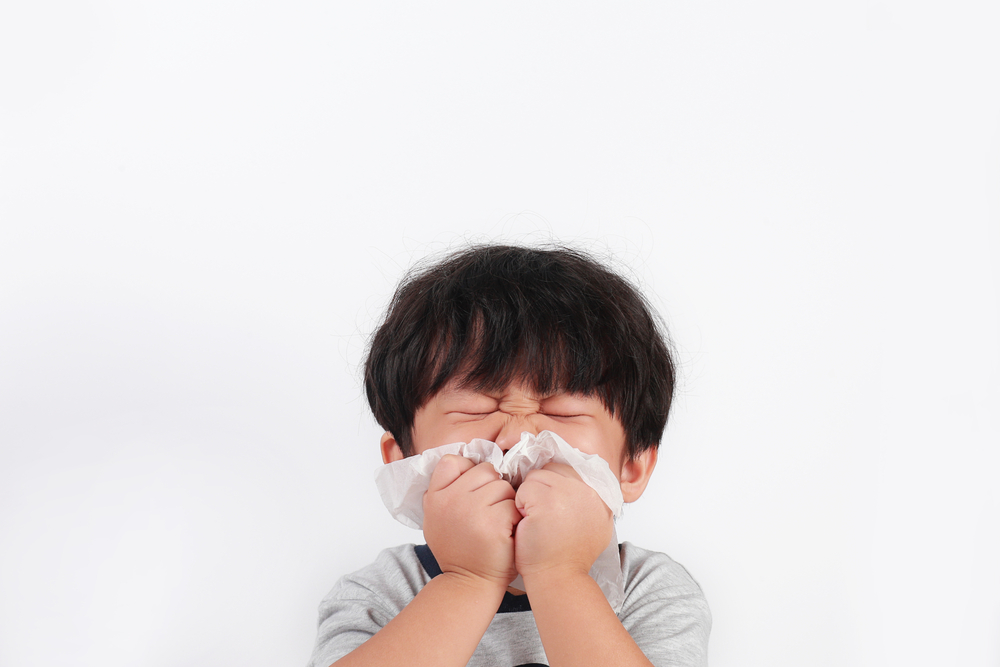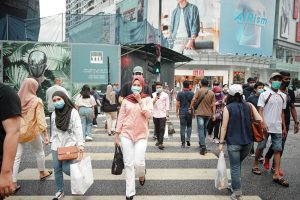In Asia, the prevalence of allergic rhinitis mainly depends on the geographical location and population. Research has shown that the greatest factor to developing allergic rhinitis is family genetics, compounded by personal factors such as stress levels and personal hygiene. Despite being a mild allergy, children with allergic rhinitis are 19 times more susceptible to hospitalisation when they are exposed to another allergen or co-infected with another rhinoviral disease.
Read on to find out more and what you can do to prevent triggering an allergic episode.
What is Allergic Rhinitis?
Rhinitis is the inflammation and swelling of mucous membranes in the nose. It can be classified as allergic or non-allergic. Allergic rhinitis occurs when the immune system reacts to irritants (allergens) in the environment, causing the body to elicit an allergic reaction such as sneezing or a runny nose.
Symptoms
Symptoms observed in allergic rhinitis are similar to the common cold but persist over a longer period. It is characterised by at least one of these clinical symptoms:
- Persistent nasal obstruction, blocked nose
- Mucus discharge
- Sneezing
- Runny nose, stuffiness
- Watery, itchy eyes, ears, nose and throat
- Sinusitis and ear infections
- Headaches and swollen eyelids
What causes it?
Allergic rhinitis can be classified into perennial allergic rhinitis and seasonal allergic rhinitis. Perennial allergic rhinitis occurs all year round and is triggered by day-to-day allergens such as dust, dust mites, mould, pet fur and certain types of foods. Seasonal allergic rhinitis occurs when the seasons change, which causes larger amounts of environmental allergens such as pollen from plants to be released into the air.
High humidity allows for allergens, especially dust mites, to fester. It is actually the faeces and body fragments of dust mites that make up harmful irritants (allergens). In high humidity, these dust mites feed on our sloughed off skin cells and absorb moisture through their bodies, leading to higher rates of breeding and faeces being produced.
Allergens cause the production of antibodies when they encounter mucosal surfaces in the nose and throat. These antibodies release chemicals such as histamine, resulting in inflammation in the linings of the nose and the production of excessive mucus.
Who is most at risk?
Despite being largely influenced by genetics, it is not fully understood why some are extremely sensitive to certain allergies. In the case where there is a family history of allergies, patients are classified to have atopic allergic rhinitis, where there is a genetic tendency to develop different types of allergic diseases. This is mainly due to an oversensitive immune system that has an increased immune response to allergens where the body produces an increased amount of immunoglobulin E (IgE) antibodies to generally harmless substances in the environment, resulting in the manifestation of symptoms.
Allergic Rhinitis in children
Children with asthma are at higher risk for allergic rhinitis. For children who have both asthma and allergic rhinitis, each condition needs to be treated separately. A prominent symptom in younger children is coughing. Children with allergies may also suffer from itchy and red eyes (allergic conjunctivitis) and be prone to middle ear problems. Nasal congestion can also affect sleeping and can cause dry mouth, affecting exercise in children and their performance in sports.
Diagnosis
The environment plays a big part in triggering allergic rhinitis. Co-infection with other viral diseases and ongoing pulmonary diseases might make it harder to diagnose this condition. There are various ways to diagnose allergic rhinitis:
- Physical examination and history of symptoms, including family history of allergies
- Skin testing – skin patch or prick test
- Blood test to check for antibodies being produced against unknown allergens
- Rhinoscopy to look in the sinuses and upper airways for swollen tissue inside the nose, possible nasal lesions or polyps causing blockage
- X-rays, CT scans, or MRIs to detect chronic inflammation of the sinus lining or cancer
Asthma is usually the most common disease that is co-present with allergic rhinitis.
Prevention of Allergic Rhinitis
The best way to prevent being triggered is to avoid the allergen that is known to cause irritation. Some ways to avoid irritants are:
- Removing carpets to reduce dust
- Wash bedding in hot water (above 60 degrees Celsius) to kill off dust mites and using allergen-proof sheets
- Installing air purifiers containing HEPA filters to improve ventilation by maintaining air at a low humidity, preventing mould formation and improving quality of air
Treatment
Non-drowsy Antihistamines
Antihistamines help to neutralise the effect of histamines, a chemical released into the bloodstream in response to the allergen. They are used in milder cases where symptoms are not frequent or do not last for long periods.
Decongestants
Decongestants help to provide relief by controlling allergy symptoms but do not counter the effects caused by the allergen. They help by shrinking swollen membranes.
Saltwater solution
A drug-free saline solution is flushed through the nose via a nasal irrigation (squeeze bottle) to help remove allergens and relieve blocked nasal passages. Isotonic washes can be used to clean the nose daily but hypertonic washes for clearing blocked nasal passages are only recommended for use when an allergy acts up.
Nasal corticosteroid sprays
Nasal corticosteroid sprays are the most effective in decreasing moderate symptoms and nasal inflammation. Consistent usage shows the best results, with maximum effects usually seen in 2 weeks.
Leukotriene receptor antagonists
Non-steroidal oral medication that is also used for the treatment of asthma.
Conclusion
The best course of action is to identify the main allergen causing allergic rhinitis, especially in children where it may hinder their day to day activities the most.













